Special to the Sun Times News Online
by Matt Ankney
 photo by Matt Ankney
photo by Matt Ankney
An alleged cabal of Missouri’s most powerful political and financial forces schemed for years trying to ram through an open pit fracking sand mine in Ste. Genevieve County, according to recent conversations with state level representatives, former park employees, lobbyists, and board members of environmental organizations. The system appears rigged against those living near the controversial NexGen Silica mine situated between popular Hawn State Park and serene Hickory Canyons Natural Area. The Department of Natural Resources (DNR), the environment’s main state regulator, is tasked with protecting residents from industrial carcinogens and airborne pollutants by, in this particular case, scrutinizing the intent and behavior of mining operations and policing their actions when necessary, not rubber stamping mines near beloved parks for a handful of special interests and suggested political quid pro quo in the form of standard road improvements.
The area’s native 500-million-year-old Lamotte sandstone bedrock is a choice material prized by the fossil fuel industry for its small glass beads of silica perfect for natural gas extraction called fracking. This is the scenic Highway 32 corridor’s second fracking sand mine approved in the last decade. A Kentucky based company, Summit Proppants, LLC, fracking sand mine on Colony Church Road east of nearby Farmington was opposed by St Francois County residents, approved by the DNR, and went defunct after a few years once the unstable price of natural gas collapsed and fracking became cost ineffective almost overnight. This theme of fracking sand mine boom and bust, leaving rural communities with nothing but broken promises and destroyed land, is common across the United States in places like Iowa, Missouri, and Texas.
 Coarse grains of silica found in Lamotte sandstone, photo by Matt Ankney at Hawn State Park
Coarse grains of silica found in Lamotte sandstone, photo by Matt Ankney at Hawn State Park
Residents living near the proposed fracking sand mine near Hawn State Park in Ste. Genevieve County expected at least a fair process in the form of many things, including a robust environmental impact study of the proposed site using the most up-to-date scientific methods; they instead received an upcoming Missouri Administrative Hearing Commission appearance in Jefferson City on September 27th that also appears tipped in favor of the Show-Me-State’s political Masters of the Universe and their NexGen Silica allies and possible patrons, which our opaque campaign finance laws in the form of “dark money” contributions makes it impossible to verify, by design.
The unexplained behavior of the Department of Natural Resources to not perform an environmental study when the almost trillion-gallon St. Francois Aquifer is at stake, a massive underground body of freshwater the open pit mine intends to tap and ultimately waste on levels the area has never seen, and the water supply of Bonne Terre, Farmington, Fredericktown could be depleted or contaminated, people begin to ask serious questions about money influencing these recent suspicious decisions and if they can trust their state government to protect our precious natural resources; making sure our friends and neighbors do not die from unnecessary cancers and industry-caused ailments. The important point about the Missouri environmental phenomenon known as “cancer clusters” is that individuals or random occurrences are not their main source, but instead the culprits are mostly profitable business enterprises like landfills, power plants, factories, toxic waste storage facilities, defunct experimental energy sites, and of course mines.
Republicans running this Red State in their political supermajority, where they control all levers of consolidated power, should understand their rural voters in Ste. Genevieve do not want to live in a cancer cluster, nor do park visitors and owners wish to frequent them. The mining industry is rarely held financially responsible for their externalities of environmental destruction and history of human disease associated with mining. You pay for the expensive cancer treatment, you pay for your child’s asthma medication, you pay to mitigate the harm done to your property, water is trucked in at your expense if the aquifer is depleted, not the mining company and their investors, shoving the major costs and responsibility onto the individual taxpayer. Poor health outcomes due to industry in Missouri are no surprise as our children have some of the highest levels of toxic lead in their blood, requiring school water fountains to have special filtration added at extra cost to the public, not the highly profitable industry responsible for the widespread contamination.
An incredible number of concerned Missourians and supportive visitors have spoken out against the NexGen Silica fracking sand mine, doing what they can in their own time and individual capacity, trying to help the park and the citizens of Ste. Genevieve, whether that means writing letters, posting messages on social media, or making phone calls. Dr. Mark Routberg, an internal physician residing in St. Charles, Missouri with a fondness for the area’s ecological importance and natural beauty, has been working for months contacting media, environmental organizations, and government officials expressing his professional concern for residents’ health living near the proposed open pit mine facility next to Hawn State Park, “Pulmonary silicosis is a very serious thing you really don’t want to get and from what I know about the mine, it is going to be almost impossible not to breathe fine particles of sand, leading to cancer and other preventable ailments. The (St. Francois) aquifer poses another problem because they tend to get sucked dry.” Found within NexGen Silica’s promotional materials about the proposed open pit mine site provided to the public, on-duty personnel at the facility outdoors will be required to wear OSHA approved protective respirators. A candid staff member with the DNR Office of Mining and Land Reclamation, the division responsible for examining one of NexGen’s permit applications, revealed to a stunned Dr. Routberg in June that the underground aquifer contamination “won’t reach Hawn State Park for a hundred years” in what was described as a dismissive manner, according to Dr. Routberg, as an attempt to downplay the issue’s serious nature.
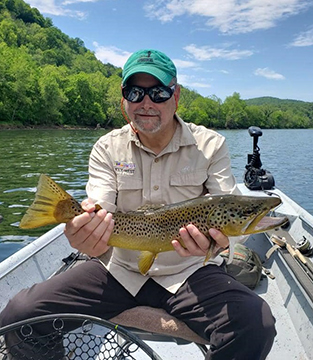
Dr. Mark Routberg, M.D.
In ongoing and recent conversations with residents of neighboring Farmington in St. Francois County, even though they share the same underground water supply with Ste. Genevieve County, news about the threatened St. Francois Aquifer appears to have never resonated, their own local publications ignored the serious environmental aspects of the story over the last four months, and concern remains low as the community seems under informed about the controversial NexGen Silica mine’s potential impact on over 200,000 residents in 7 surrounding counties. The lead mining tradition is strong with a history in this area beginning with French settlers from the 1700’s to 1972; Farmington’s prominent water tower today reads “Progress and Tradition”. In the near future, water stored in the white and blue above ground tank next to Highway 67 might be contaminated from the NexGen Silica fracking sand mine miles away. There are no precise, time sensitive safeguards in place to ensure the community does not consume a portion of the potentially toxic water before it is discovered and mitigated, leaving residents possibly dry for an extended period of time, relying on expensive alternatives creating a container waste crisis. The nuanced manner in which this fracking sand mine is connected to so many aspects of the entire Southeastern Missouri region, not including just Ste. Genevieve and the immediate vicinity around Hawn State Park, and how it might ruin Missourians’ lives, property values, businesses like wineries depending on water, or even sicken them with rare cancers, cannot be ignored and the absence of dialogue, solidarity, and support between rural communities at this point is significant. The complete and permanent sacrifice of forest habitat and arable farmland, the irreversible alteration of our valuable land for fossil-fuel sand mining is an accelerating trend in the Midwest.
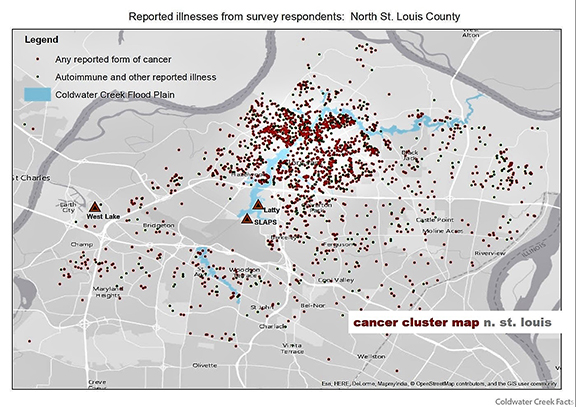 Cancer clusters are common near industrial sites regulated by the DNR in North St Louis County
Cancer clusters are common near industrial sites regulated by the DNR in North St Louis County
An important point unconsidered is the controversial NexGen Silica fracking sand mine requires an unlimited, unsupervised supply of underground freshwater and the company believes it has a right to tap as much as it wants for as long as it wants under any circumstances with the blessing of the DNR. In other past scenarios, mining companies in the United States have sued local areas when rural communities tried to stop similar mines from using all their public water once their aquifers became depleted by the mine. The permitting process the Department of Natural Resources handled seems incomplete in a particular manner. The mine, according to NexGen Silica’s own promotional materials, is actually by definition not only a bedrock extraction company, but also a freshwater extraction operation and should be considered under the legal terminology an “aquifer miner” Aquifer Mining Definition | Law Insider, prompting more robust scrutiny and skepticism by the DNR environmental authorities, not by-passing impact studies when the area’s freshwater stakes are so high and regurgitating industry talking points to concerned, experienced citizens like Dr. Mark Routberg who understands the science behind disruptive industrial facilities like the proposed NexGen Silica mine next to Hawn State Park. In this respect, the NexGen facility is not a sand mine, but a water mine extracting the natural resources of the almost trillion-gallon St. Francois Aquifer filtered only by the simplistic magic of Mother Nature with Lamotte sandstone and gravity. The company’s intent for water usage and also prioritizing the sandstone bedrock removal as the primary extraction should not factor in determining the designation of “aquifer miner”.
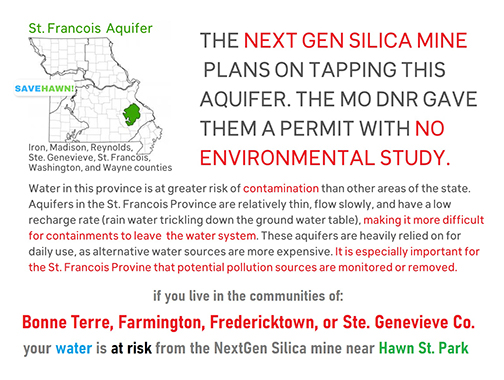
The local Ste. Genevieve citizens’ complaint filed by Operation Sand, LLC alleges: “1. NexGen Silica (mining company) failed to identify all persons involved with any interest in the land to be mined; as required by law. 2. NexGen failed to show it has an actual legal right to mine the land; as required by law. 3. The Department of Natural Resources failed to examine and investigate the permit application; as required by law. 4. Due to numerous technical problems and poor organization, The DNR and NexGen failed to make arrangements for the public to learn about the proposed mining operation and ask questions of the DNR and NexGen. Most importantly, the complaint references a letter from NexGen to the DNR in which NexGen entered into a mine lease agreement with a company called “Missouri Proppants, LLC”. However, the Missouri Secretary of State issued a Certificate of Fact indicating no such entity active, registered, or authorized to do business in Missouri. As a result, there is no valid lease agreement and NexGen cannot show it has a legal right to mine the property; as required by law.” The local offices of NexGen Silica were contacted for comments regarding this article and no answer was received.
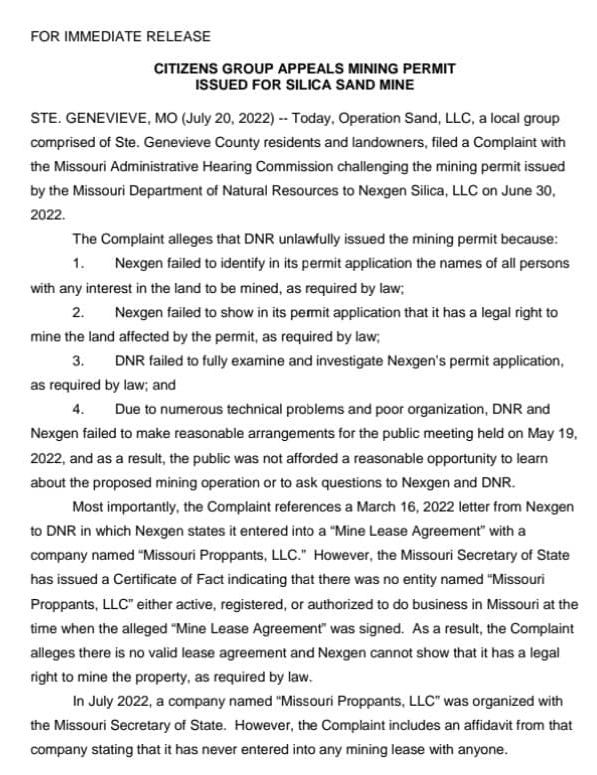
The Director of the Department of Natural Resources is appointed by Governor Mike Parson, as are the four judges on the Missouri Administrative Hearing Commission the citizens’ complaint will face on the 27th and could determine the ultimate fate of the Hawn State Park area. Even more curious, the commissioner appointed to the case, Philip Prewitt, has no environmental law in his resume. The Office Supervisor of the MAHC, a partisan, non-independent commission, told me an unidentified “clerk” assigned individual cases to the appropriate commissioner based on their background and personal history with certain issues, but no further explanation was provided when confronted with a question that Commissioner Prewitt seems inadequate for such a high stakes case involving the estimated 919 billion gallon St. Francois Aquifer the nearby communities of Bonne Terre, Farmington, and Fredericktown share with Ste. Genevieve County. A quick scan of the MAHC’s own website, State of Missouri Administrative Hearing Commission (mo.gov), allows the public to determine other commissioners have more robust environmental experience suited for assessing this serious issue with a seasoned, critical eye.
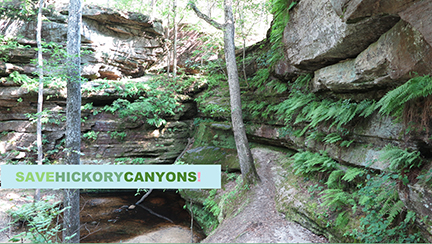 Hickory Canyons Natural Area, photo by Matt Ankney
Hickory Canyons Natural Area, photo by Matt Ankney
The complaint references a point where the people’s voice and concerns were ignored by the DNR; will another organization intended to serve the public also connected to the governor behave any differently as the public witnesses similar patterns emerging? Will citizens of Ste. Genevieve and owners of Hawn State Park finally receive a fair hearing on the 27th, or is this game perhaps rigged against the public because money is on the line?
 Matt Ankney is an outdoor photographer, accomplished hiker, and Ozark wilderness guide. You can hear him live Monday, September 12th on KSGM AM 980 @ 12:30 pm speaking with host Don Pritchard about his exclusive article.
Matt Ankney is an outdoor photographer, accomplished hiker, and Ozark wilderness guide. You can hear him live Monday, September 12th on KSGM AM 980 @ 12:30 pm speaking with host Don Pritchard about his exclusive article.
For more information about this important issue: (20+) SAVE HAWN! | Facebook
SAVE HAWN! – A Warning from the Heartland (short documentary): https://youtu.be/_toRpZpOFGU
Sources:
Missouri bill would require schools to filter drinking fountains for lead (newstribune.com)
Cancer Clusters Fact Sheet – NCI
Missouri’s dark money scandal, explained | AP News
https://civileats.com/2022/07/19/from-farmland-to-frac-sand/
https://www.texasstandard.org/stories/neighbors-struggle-with-south-texas-sand-mining-boom/
https://www.texasmonthly.com/news-politics/why-did-las-moras-fort-clark-springs-dry-up/

